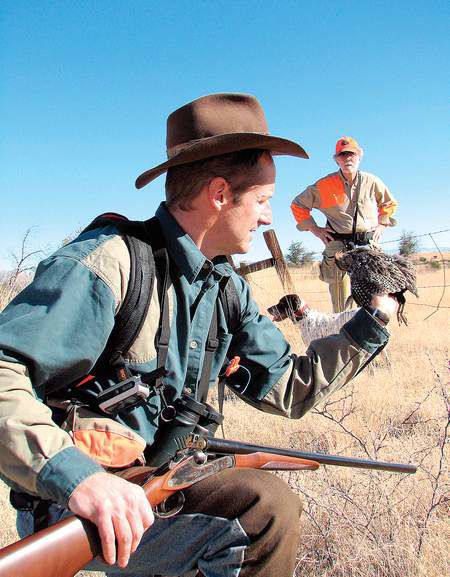Captivated by quail in Arizona
Published 4:00 am Thursday, December 25, 2008

- Gary Lewis and Bob Mulligan admire their quarry, a Mearns’ quail from the southern Arizona desert. Mearns’ quail, also called Montezuma quail, hold better for a gun dog than any other quail, yet they fly faster and are more unpredictable when flushed.
A general named Crook with a weakness for bird hunting found himself, after campaigns across the West, back in Arizona.
One of his key strategies was the use of selected Indian scouts to guide each column of soldiers. The scouts were kept one to two day’s march ahead of the army and up to 50 miles along each side.
An Apache tradition says that Geronimo actually captured Crook while Crook was out hunting by himself too far from the column. But Crook’s strategy had been so effective that the renegades surrendered.
We found ourselves in Arizona at the end of November.
“Lady, whoa.” The German shorthair keened and quivered. She looked at each of us in turn to make sure we were ready.
Bill Valentine thumbed three rounds of No. 8s into his Browning. My dad broke his borrowed over/under and dropped two loads into the chambers. Clunk-clunk.
Drops of dew clung to the tops of the yellowed chest-high grass and glistened on the cholla and the prickly pear.
“This early in the season, the birds are out in the tall grass in the flats. Later in the day, we’ll find them up in the brush.”
Lady cut back and forth, sometimes bouncing up on her back legs to catch a glimpse of her master. Then, at the mouth of a canyon, her head lifted and she sorted out scents borne on tendrils of wind.
I stayed low, while Bill took a Coues deer trail below the crest. Dad and Bob stayed close to Lady in the high grass. She stiffened, locked up, and a bird launched into the air, followed by another and another. At once, in a blur of wings and sound, almost a dozen quail were aloft.
Dad’s shotgun thumped and one bird crumpled. One came my way and flashed by, headed uphill.
I swung my CZ side-by-side, squeezed and watched the quail fall and roll. Bob knocked another down as it crested the opposite ridge.
One of the singles touched down next to Bill and he walked right into it, flushed it and connected before the bird could put an oak tree between them. Ten minutes into our hunt, we had each bagged a Mearns’ quail.
I almost thought it was easy, until I saw Lady shouldering through the cholla and catclaw on the next point. She went rigid in the bottom of the draw and seven or eight blurred birds broke away. This time I was in position for shots at two of them and knocked one down going around an oak tree. I finished the two-hour morning hunt with three polka-dotted quail and a mourning dove.
South of Tucson, harsh mountains rise steep out of the arid desert plane. The Huachucas, Santa Ritas, Sierritas and other high desert ranges of the Coronado National Forest are home to Mearns’ quail, a long-toed scratcher of the tall grass, scrub oak and cactus uplands.
Mearns’ quail have black and white heads which almost seem too big for their bodies, capped with a rusty crest. On the male, the brown and black checkered backs and flanks are spotted with white darts. Breasts are mahogany colored, blending to black at the rump, with a stubby tail. The female is cinnamon colored with brown, black and tan.
Once thought to be extinct, the birds are found in huntable numbers in wide flats with thick grass as high as a man’s belt buckle. For the birds to thrive in spite of bobcats, coyotes, hawks, and long, hot months without rain, they require tall, thick grass, loose soil and overstory — qualities found in highest proportions when the land is grazed lightly.
Best of all, this bird holds better for a gun dog than any other quail, yet they fly faster, more unpredictable when flushed. At the covey break, the quail scatter and the singles hold so tight that the hunter must almost step on them to get them to flush. The dry air and grass hold very little scent to allow the dog to find them again.
On our second day we passed checkpoints and dodged Border Patrol trucks hurtling along mountain roads. Miles in, we found a canyon with tall grass and good cover that sheltered not only the quail we coveted, but the quarry the men and women in the green and white trucks were hunting. We found their spoor: empty refried bean cans, water bottles and backpacks.
On day three, on the shoulder of a ridge, Lady pointed the covey just for me. I missed one as it broke toward Bill and Bob over the valley. Reloading, I missed another with both barrels.
Crashing through thigh-high catclaw, clinging to oak branches on the steep slope where the rocks rolled like marbles, I’d missed five for five. For now, I’d be content with taking pictures of Dad, Bob and Bill with their birds.
Lady, our scout, her legs flecked with cactus wounds, ranged ahead, still hunting as we headed back to the truck — all captivated, if not captured, by Mearns’ quail.






